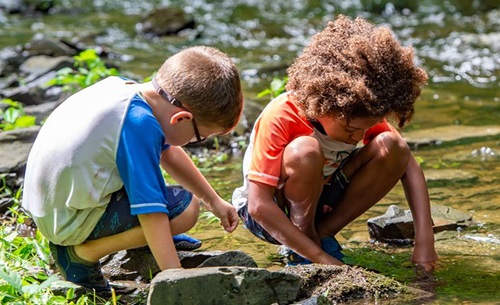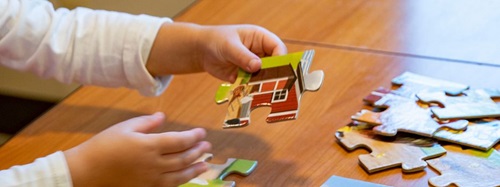The Project Approach and STEM:
A Powerful Combination
|
February 2016
Introduction
There are countless methods and approaches to teaching, but it is clear that children learn best when engaged in authentic and relevant activities. Two well-known approaches, project-based learning and STEM-based learning, hold to the common philosophy that true education inspires and motivates children to be lifelong learners. The Project Approach offers children open-ended experiences as the basis of the curriculum. STEM programs focus on expanding a child’s knowledge and interest in the science and math domains. What happens when these two methods are merged? A lot of potential for real-life learning!
What is the Project Approach?
The Project Approach offers teachers a way to develop in-depth thinking while engaging the hearts and minds of young children. Project work presents many opportunities to value young children’s ideas, encourage their creativity, nurture their interests, and meet their learning needs.
In early childhood, projects can be defined as open ended studies of everyday topics. Project topics are selected by the teacher and frequently emerge from the questions children raise and develop according to their interests. Rather than offering immediate answers to the questions children ask, teachers provide experiences through which children can discover the answers themselves through inquiry at field sites or interviewing experts.
What is STEM?
STEM is an acronym representing the four academic disciplines of science, technology, engineering, and mathematics. This approach to teaching is interdisciplinary—the four subject areas are integrated through systematic investigation and real-life application. Learners are encouraged to participate in discussing and working on relevant lessons, doing field studies, and consulting with experts outside the classroom.
A natural and powerful combination
Since both approaches promote a holistic integration of the different subject areas they naturally complement each other. There are countless methods of infusing educational programs with STEM learning, but often—particularly with older children—an overly structured curriculum artificially separates the different domains of study. For example, science is traditionally taught by the science teacher and math, by the math teacher. Or, an early childhood teacher does not feel that they are competent to include STEM-based learning into their classroom because they have no background in engineering. The Project Approach provides a well-tested-and-tried method of incorporating all areas of learning under the umbrella of one inclusive, in-depth investigation or “project”. This makes it the perfect method to adopt for increasing a child’s STEM skills and knowledge.
Projects are based on the classical scientific method in that they begin with questions about the area of interest and predictions of possible solutions or outcomes, the gathering of data, and finally, communicating the results.
Investigating the purpose of recycling: How long does it take for different materials to disintegrate when buried in dirt?
The Structure of the Project Approach
Phase 1: Launching a project: Students’ Initial Understandings
In the beginning of a project, the teacher builds interest in the topic through encouraging the children to share relevant personal stories of experience. As the children represent their current understanding of the topic of study, the teacher assesses the children’s vocabulary, their individual interests, misconceptions or gaps in current knowledge, and helps them formulate questions which they can investigate. In projects with a STEM focus, the teacher can relate these preliminary explorations to knowledge and skills involved in science, technology, engineering, and math. There will also be opportunities to introduce new vocabulary that is associated with those STEM subjects.
Phase 2: Developing a Project: Building the Knowledge
As the inquiry enters the research phase of the work, teachers arrange field visits where children can interview experts, such as waiters, farmers, or nurses, for example, according to the topic of study. Children also can look at books, internet sites, or videos to accumulate more knowledge about the subject. As they learn more about the topic they use many forms of representation to illustrate what they have learned and to share new knowledge with their classmates.
Phase 3: Concluding a Project: Presenting your Work
Finally, the teacher guides the conclusion of the study and helps the children review their achievements. The children share their work with parents, another class, or members of the local community who have helped them in the process of the investigation. This final phase of the work includes the assessment by teachers of what the children have learned through the project. All children will have learned basic facts about the topic. Sharing what they have learned with others helps the children to review their achievements.
In the case of a project with a STEM focus, selected achievements can be featured showing what the STEM subjects have contributed to the study as a whole as well as to the individual explorations children have carried out.
Communicating the results of the investigation with peers.
Alignment with other curriculums
The type of learning that is seen in both Project Approach and STEM-oriented classrooms differs considerably from the pre-planned lessons of a published curriculum. While both these methods support curriculum standards in the different subject areas, teachers do not "teach to the test". The emphasis is on the context in which learning is intrinsically motivating and engaging to young children because of its focus on real world application of knowledge and skill.
Through careful observation and skillful planning on the part of the teacher, almost any curriculum goals can be integrated into project work. The teacher anticipates the directions a project investigation may take, and includes elements of the required curriculum in her plans. The teacher records the STEM subject objectives, specific skills, and knowledge in her planning, and the project documentation provides evidence of learning.
In addition to the aspects of the curriculum which relate directly to the acquisition of skills and knowledge, project work offers interesting opportunities for children to apply and practice what they learn in other parts of their daily program in school. Focusing on STEM subjects does not mean the exclusion of other subjects. Subject integration enables children to learn through projects in personally meaningful ways. Children who excel in certain academic areas, for example in technology or math, learn to offer leadership to their peers. Children who experience difficulty in some areas frequently learn more easily from skilled or knowledgeable peers than from adults.
In classrooms where the Project Approach is well implemented, teachers and parents report that children show increased achievement and confidence in talking about what they know and can do. This can also apply to the less familiar subjects of technology and engineering.
Integrating these approaches into your classroom
Project work can be incorporated into already existing learning centers, as well as into a typical daily schedule. For example, circle time can be used to discuss a current investigation or books on the subject can be placed in the literacy area.
Children learn through many different experiences in school. For young children these experiences include sensory exploration, various kinds of play activity, observation, and practice. Many of these activities can incorporate STEM activities of one kind or another. When children are constructing buildings, garages, or farms, they are involved in engineering. When they are making photographic records of their work or looking at information on a computer screen they are using technology. As they apply an increasingly varied range of skills they learn some things through direct instruction, some through small group work, some through repeated trials and persistence, and some through collaboration and lively discussion with their classmates.
In classrooms where the Project Approach is already successfully applied by teachers, there is little adaptation of strategy or routine needed to incorporate a STEM focus into the work. STEM offers an alternative curriculum focus on the work of a project. The two approaches are similar in many ways as they involve the children in investigation, collaboration, and field study, with opportunities to relate their school work to real world interests.
Empowering lifelong learners
When using both the Project Approach and STEM-focused learning in your classroom, children are empowered to ask questions, investigate, problem-solve, communicate, and discover. By building on their natural curiosity instead of imposing a scripted curriculum, the children become independent thinkers and lifelong learners. The authentic learning they experience extends beyond the classroom into the world.
Authentic learning: project work has real-life applications.
References
Chard, SC. 2009. "The Project Approach: Six Practical Guides for Teachers." These guides are available as pdf files at the following web site: www.projectapproach.org
Katz, L.G., S.C. Chard and Y. Kogan. 2014. Engaging Children’s Minds: The Project Approach, Third Edition. Santa Barbara: ABC Clio.
Myers, A. and J. Berkowitz. 2015. The STEM Shift: A Guide for School Leaders. Thousand Oaks: Corwin.










